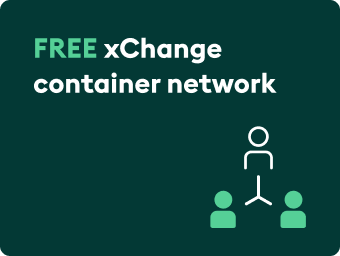Wondering how to rent a shipping container without overpaying or dealing with hidden fees? This guide will walk you through the process step by step, helping you avoid common pitfalls and secure the best deal.
Whether you’re a business owner or a leasing company, finding the right container at the right price can be tricky. That’s why it’s essential to learn a few tips and tricks for a profitable deal.
If you’re already familiar with leasing and only need to find containers, jump to our public search below and start your leasing adventure. But if you’re new to the process, keep reading—our expert insights will make your rental experience seamless and cost-effective.
0 results found on the platform.
Containers sell for up to 0/unit.
Container prices start from 0/unit.
Currently no match for your search
Change your search criteria or fill out the form below to get notified via email when there is a new match for you on xChange!
Showing 0 of 0 results
Load more()
YOM:
Year of manufacture:
per container
$
Rent a shipping container in 6 easy steps
Here are 6 simple steps to rent a container of your choice. These steps will help you understand your needs and make an informed decision for your business.
Step 1: Choose your ideal container type and size
Deciding which container type you need all comes down to what goods you’re shipping. If you’re shipping dry cargo, renting a standard shipping container can be your best choice.
Here, you can choose between the most common container sizes—20ft and 40ft—as well as their taller sibling, the high cube container.
But if you’re shipping foods, chemicals, or medicine, you should look into special containers like reefers. Or, if you are shipping out-of-gauge or project cargo, you’ll need specialized containers such as flat racks, open tops, hard tops, etc.
Get the full overview and learn more about different types of containers here.
Step 2: Choose the condition and grade of the container
Now it’s time to decide on the condition of the container. It will depend on what you need the container for.
For shipping goods, you can choose between new or cargo-worthy containers. These container conditions are ideal for shipping your cargo safely.
Read more about different container conditions and gradings to get a full overview.
Step 3: Find out how much it costs to rent a shipping container
The cost of renting a shipping container depends on several factors, like the type of leasing agreement you have, supply and demand, location, and current market trends.
That’s why it’s important to rent containers from transparent marketplaces where you can see prices upfront, negotiate further, and make sure you’re renting containers at the best prices. Container xChange can help you with that and so much more.
To give you a better understanding of the rates on our platform, here are the pick-up charges for 3 stretches below:
- The average pick-up rate for a 20ft container from Shanghai to New York is $360.
- The average pick-up rate for a 40ft container from Ningbo to Los Angeles is $410.
- The average pick-up rate for a 40ft HC from Qingdao to Toronto is $430.
Want to find the cost of renting a container for your specific route? Visit our leasing marketplace and browse through offers from vetted suppliers today (for free)!
Step 4: Choose the ideal shipping container rental lease agreement
Here are the different container lease agreements you can choose from.
| Master lease | Long-term lease | Short-term lease | One-way lease |
| Duration can vary | 5–8 years | Longer than 6 months | Duration can vary |
| Maintenance is done by the leasing company | Repair or maintenance done by the lessee | Maintenance is done by the lessee | Usually, maintenance is done by the lessee |
| Drop-off location is restricted here | The drop-off location is restricted | Drop-off location is very restricted | The drop-off location is at shipper’s desire |
| Higher cost as the lessor takes charge of the process | Negotiable rates after a few years based on market changes | High rent due to market conditions | Costs less as it’s only for one stretch |
Read more about the different container lease agreements here.
Step 5: Hire a container surveyor
A container surveyor usually conducts inspections, surveys, and examinations of container equipment before or after a company leases a container to make sure it’s in the desired condition. This is often something the leasing companies do to insure themselves.
Step 6: Transport the container
The final step to renting a shipping container is moving it to your desired location. This means figuring out the scheduling, trucking, or transporting by rail.
Some companies offer delivery services, making it convenient for you, but it’s essential to discuss this with your lessor and confirm associated costs.
Read how you can move a shipping container using different ways here.
Find shipping containers for rent at the best rates on Container xChange
Renting a shipping container is quick and easy through the Container xChange leasing platform.
Here’s how you can start renting shipping containers right away:
- Visit our leasing marketplace to create your free account
- Fill in your container requirements like route, container type, and condition
- Browse through multiple offers from vetted suppliers
- Interact and negotiate deals directly on the platform
- Say yes to a rate that suits your budget and close your deal
Create your free account today and start browsing.
How to rent a shipping container: Common FAQs
What’s the difference between buying and leasing a shipping container?
Buying a container gives you full ownership, making it a one-time investment with no recurring costs. Leasing is a flexible, lower-cost option where you pay to use the container for a specific route without the commitment of ownership.
What is the rent of one shipping container?
The rental cost of a shipping container varies based on size, location, and the market situation. On average, it ranges from $100 to $1,000 per route, with specialized or refrigerated containers costing more.
How are shipping containers leased?
Leasing a container is simple on xChange. Choose the container type and your desired route, and browse through multiple offers from suppliers. Find the one that fits your budget and close your deal.



